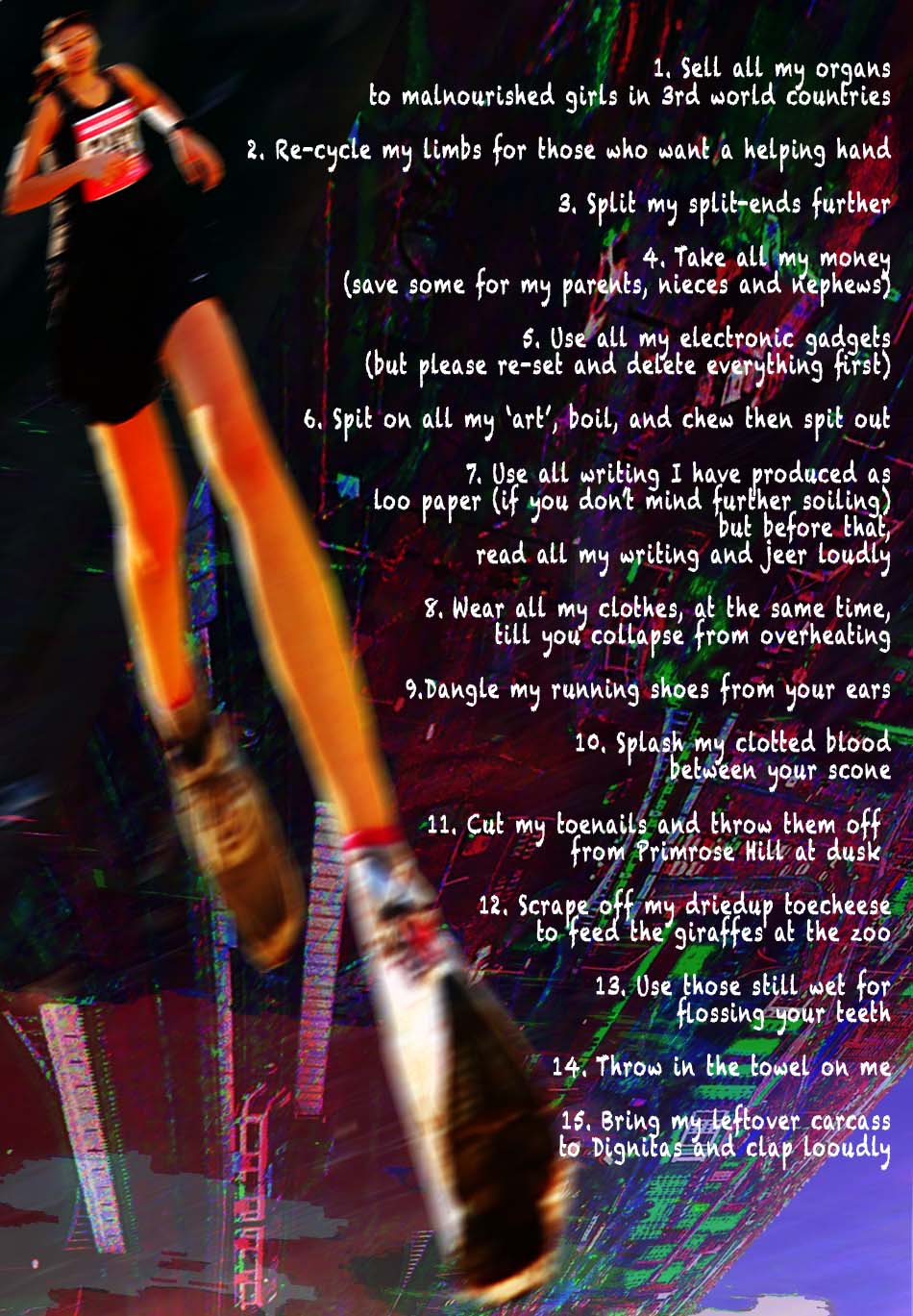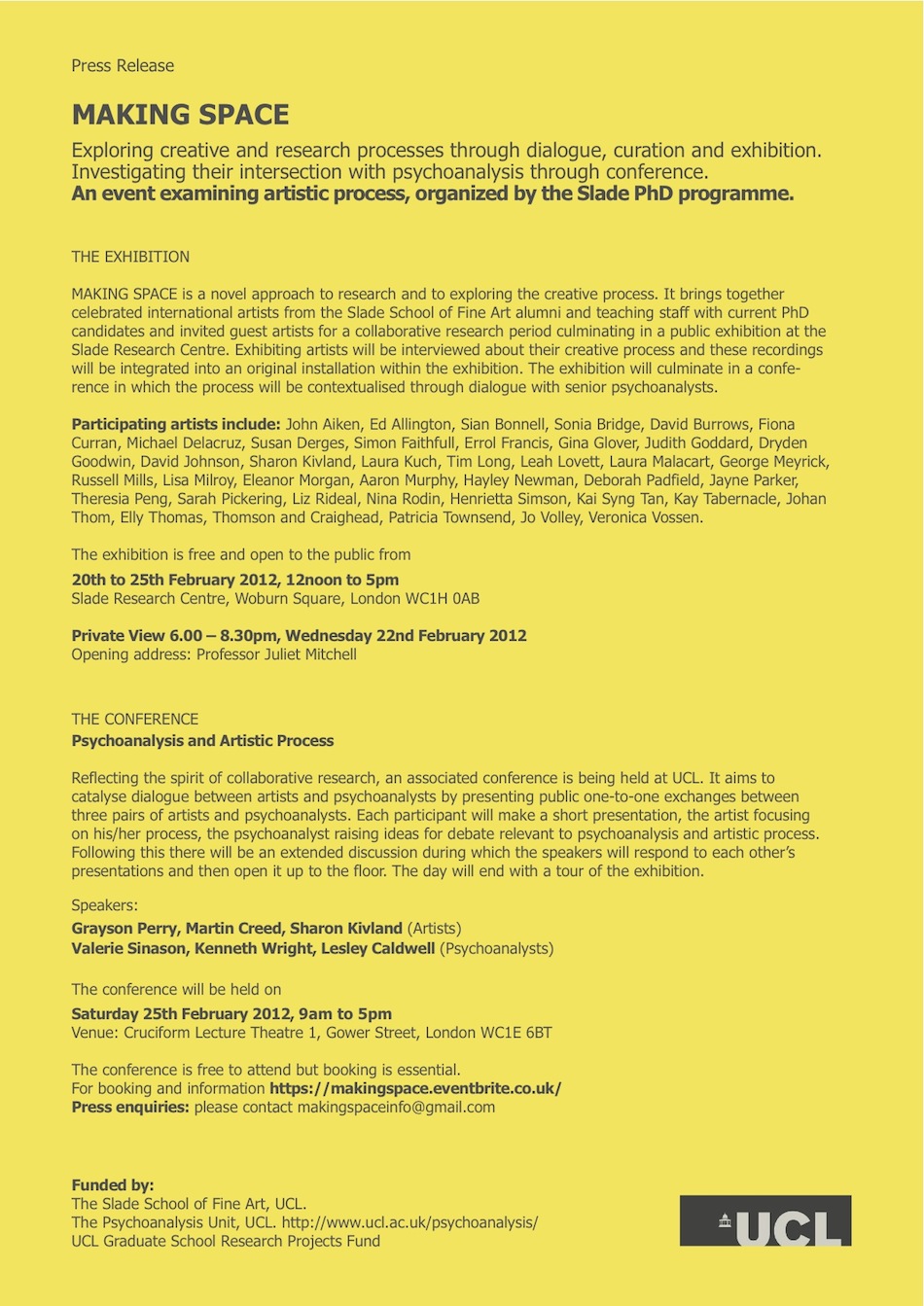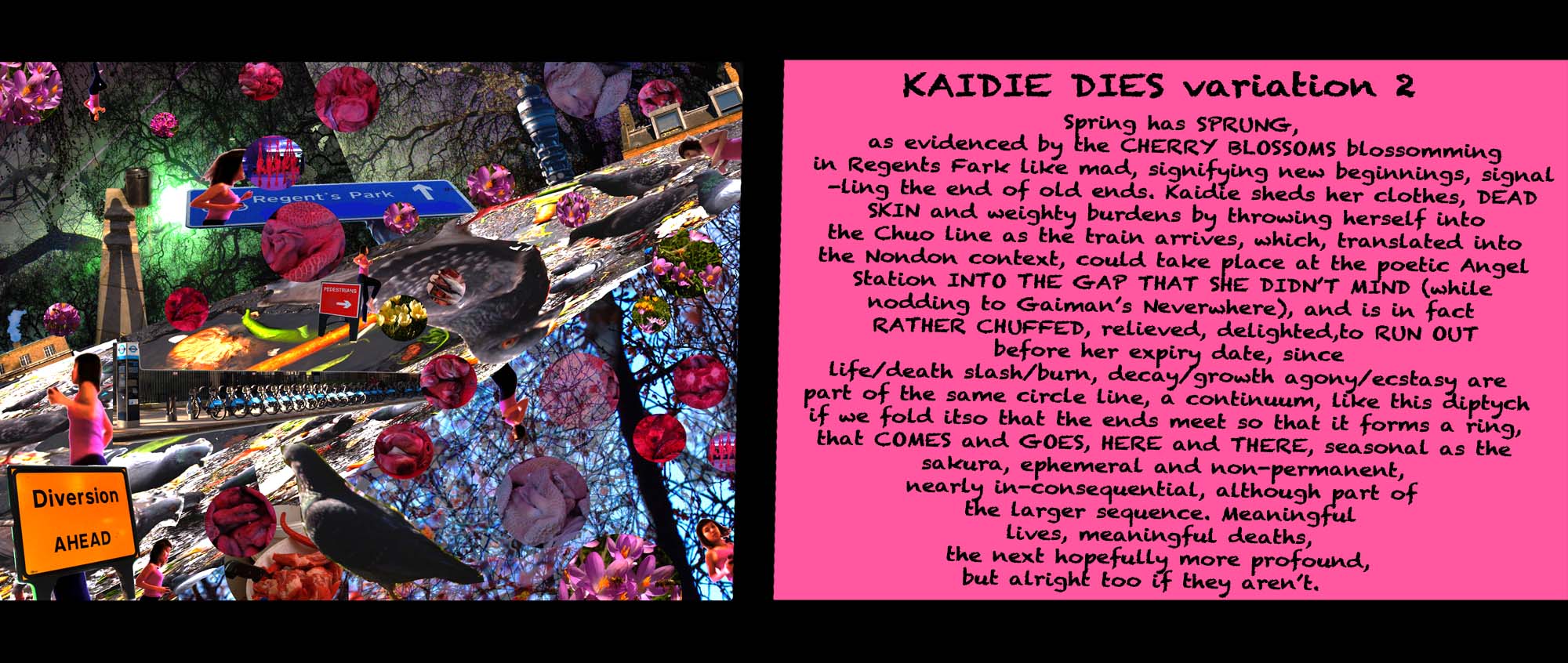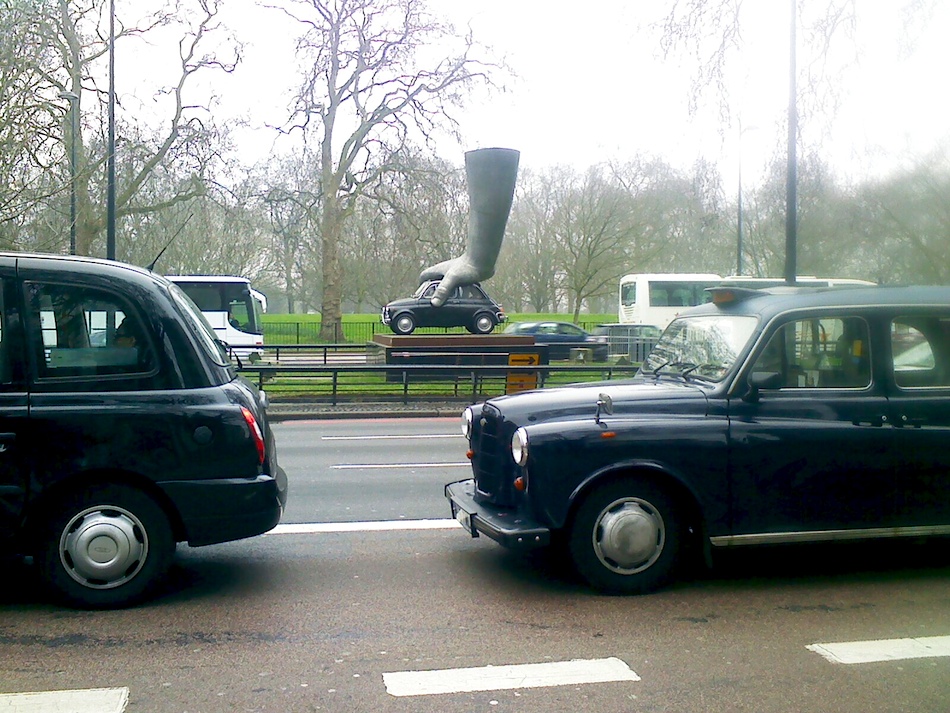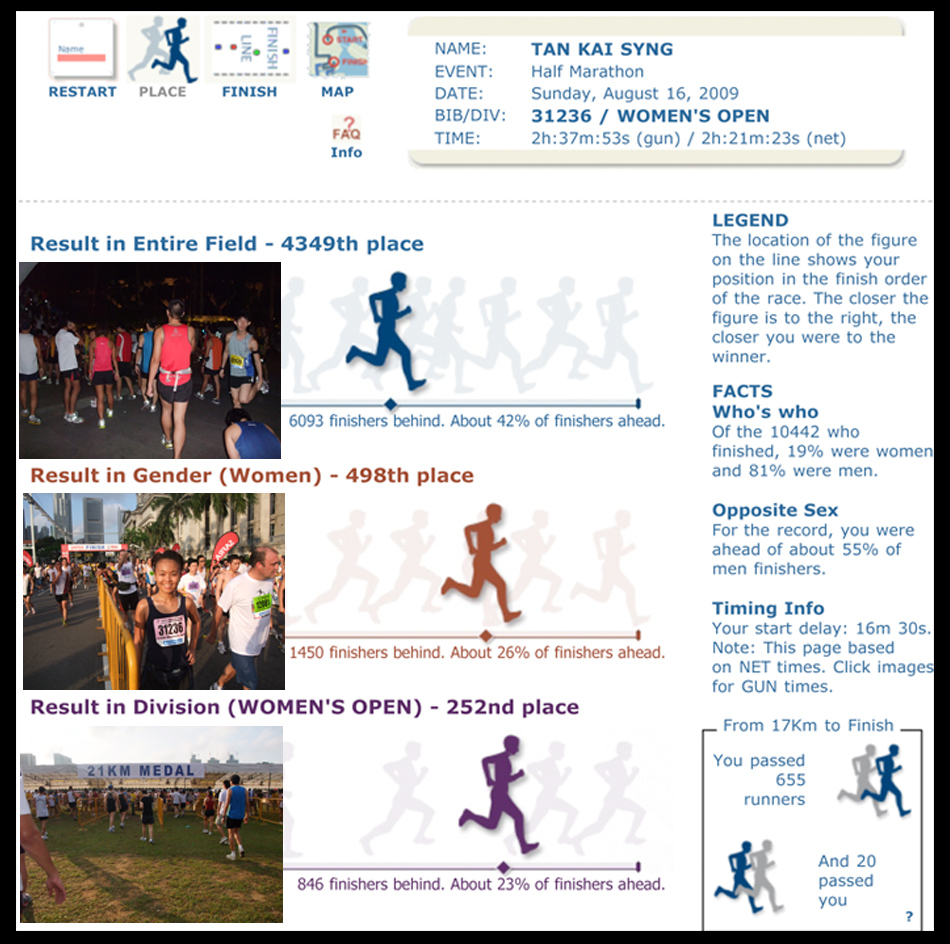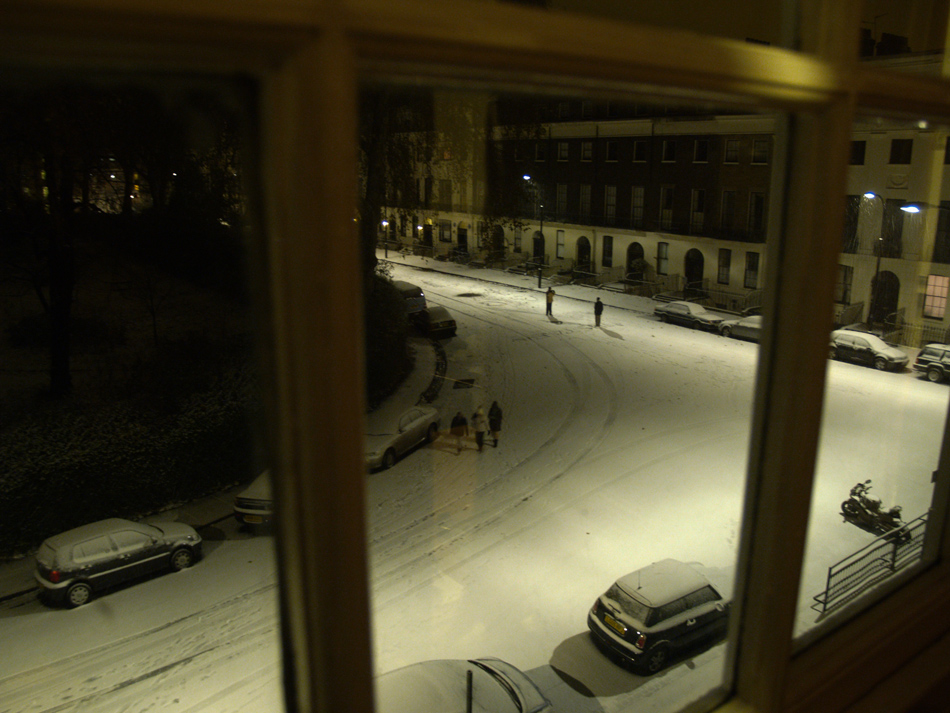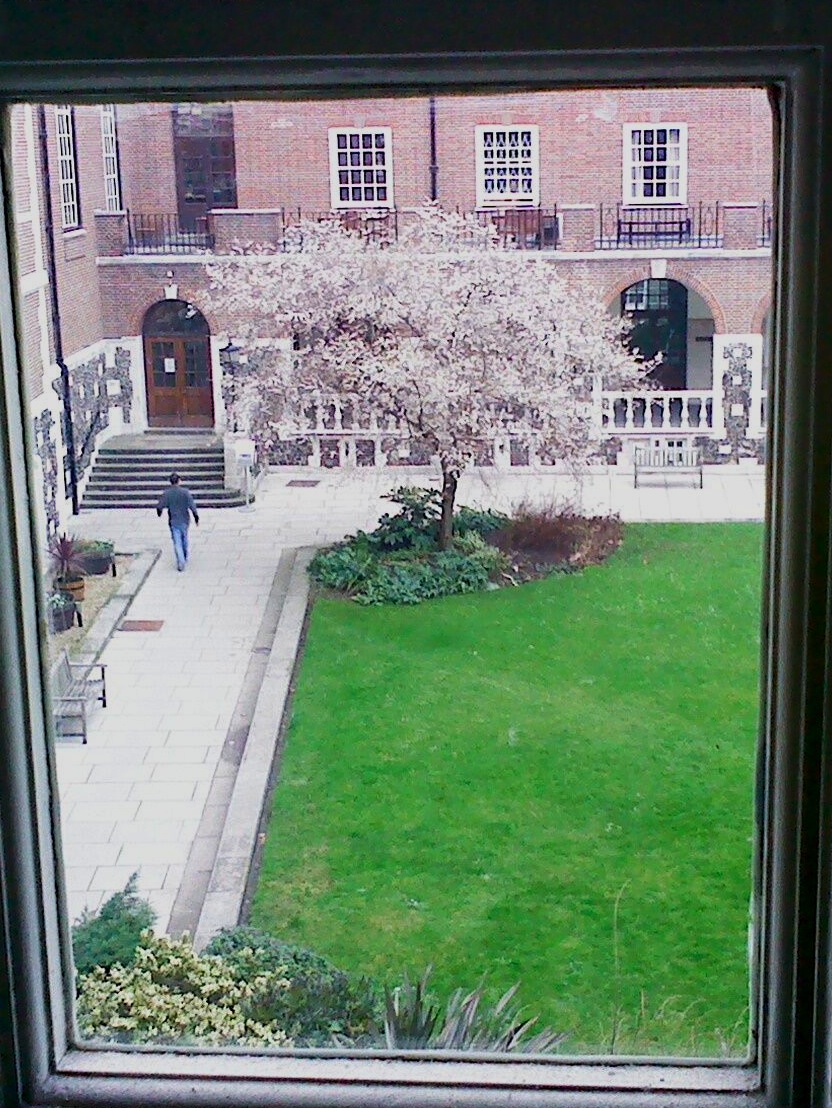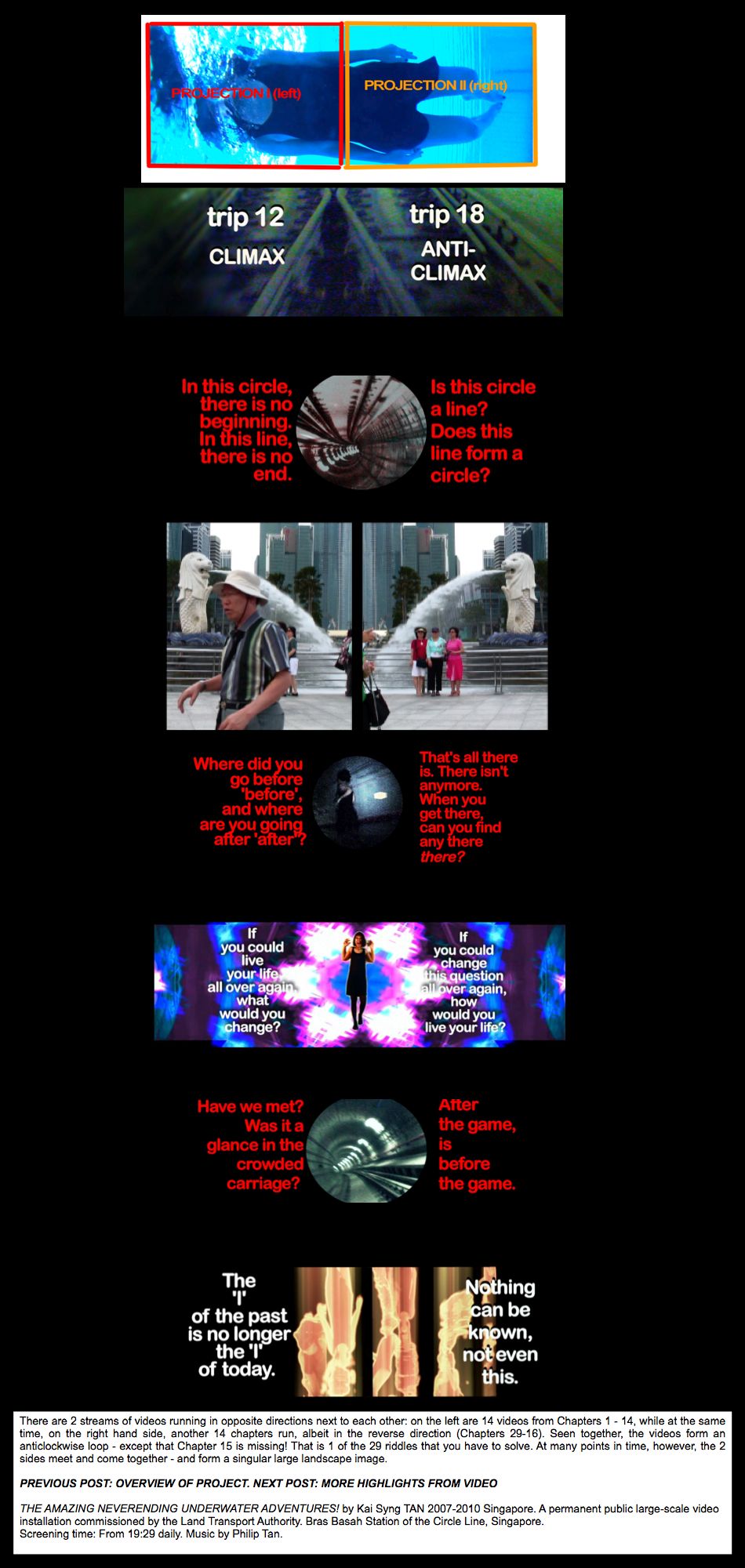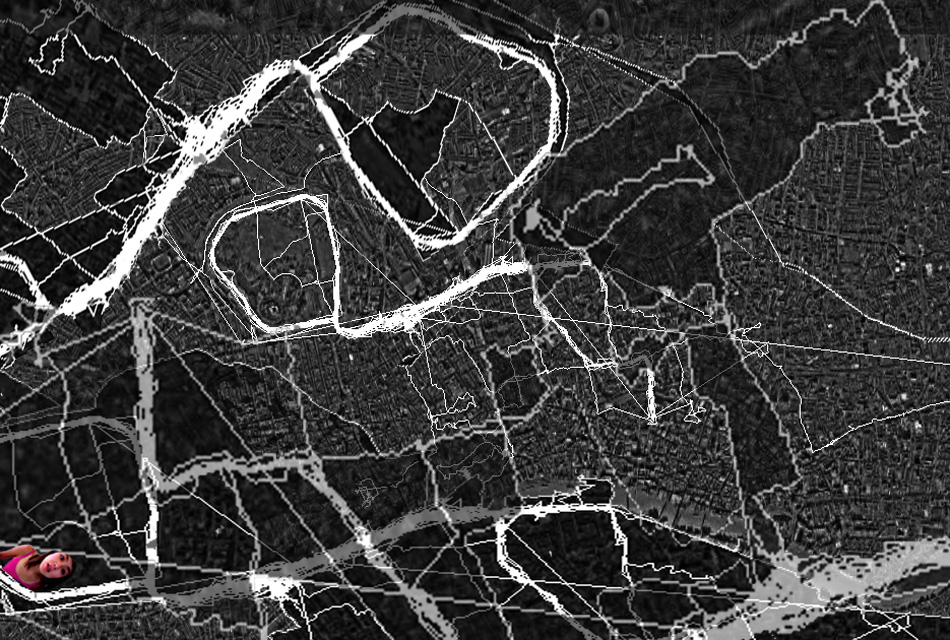KAIDIE TRANS-MIGRATING? 6
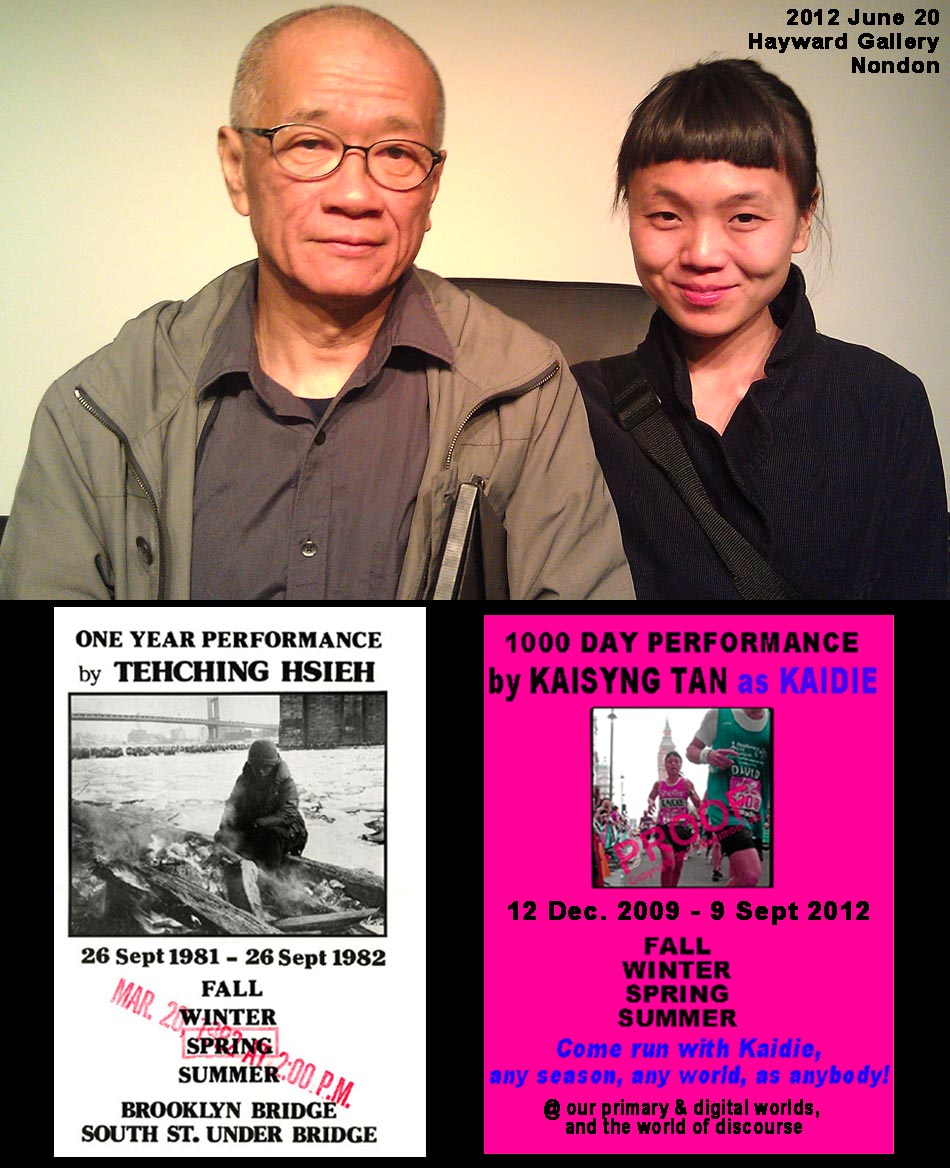
Art time, life time, passing time. Teh-Ching Hsieh with Kaidie, 20 June 2012, Hayward Lecture Theatre, Nondon.
On 20 June 2012 Wednesday, Kaidie runs into one of her forerunners, the legendary Taiwanese-American performance artist Teh-Ching Hsieh at the Wide Open School, Hayward Gallery, Nondon. Hsieh’s seminal durational performances, in particular One Year Performance (Outdoor Piece, 1982-1982), has been guiding Kaidie in her running about, 30 years on (2009-2012), not to mention that, before that, before Kaidie was Kaidie, Hsieh’s quiet but powerful works have been inspiring her in her journeys. As Kaidie prepares to run further, for the last time, in the final 80 days of her life, to have met Hsieh, face to face, eye to eye (Hsieh, like Kaidie, is not big, built like an endurance runner), has served as an important breath of life. With that, she carries on with her journeys (Photograph of Kaidie with Hsieh taken by another ‘Kai’, called Kai Nien, [unrelated]).
KAIDIE TRANS-MIGRATING? 5
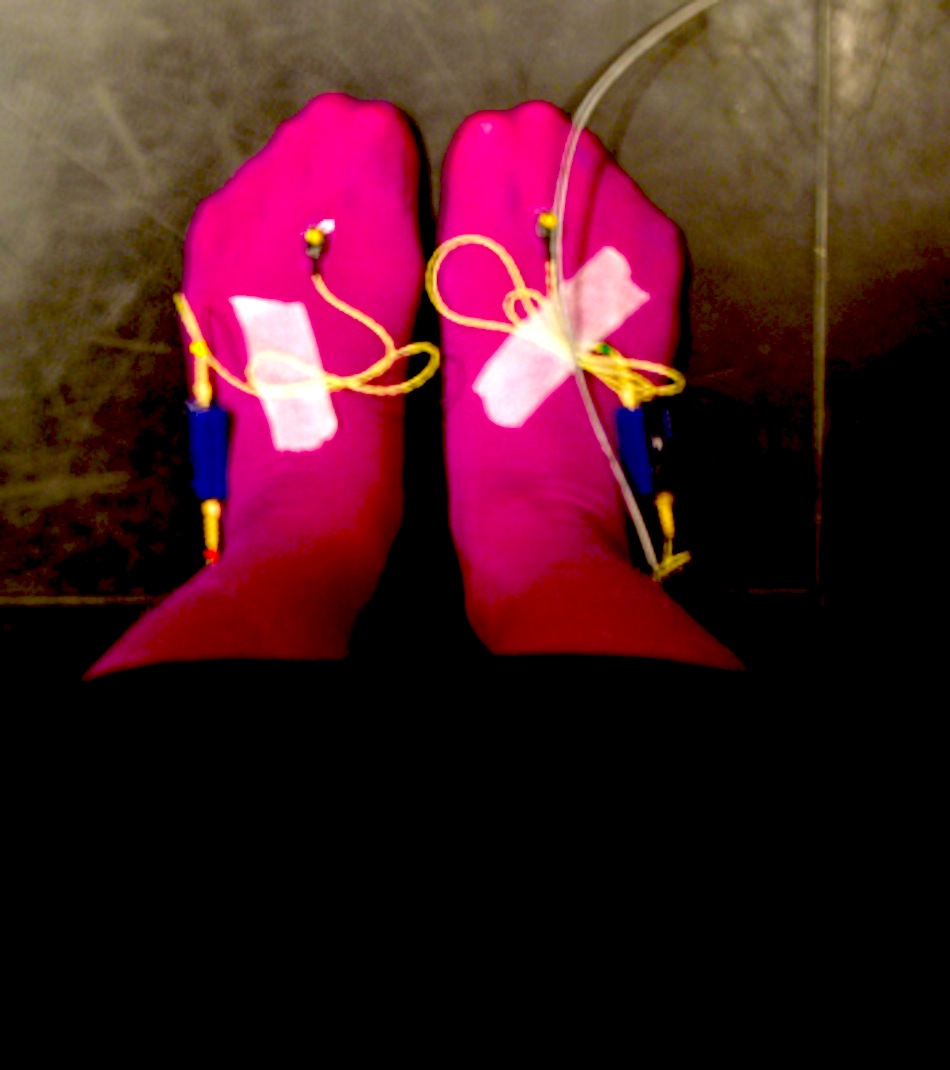
Cabled-up, taken a deep breath, pink-socked, wobbled, ready to take off, to re-turn, to life, on earth. Thummmmpppppppppppppppppppplunginggggggggggggggggggggfreefalling.................. (tbc)
KAIDIE TRANS-MIGRATING? 3
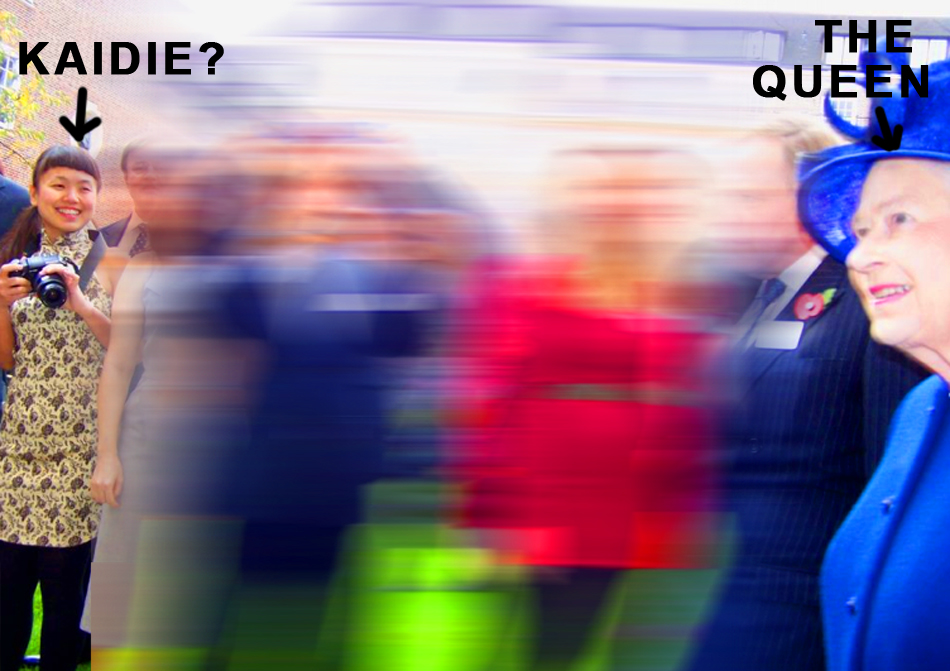
With the Queen's Diamond Jubilee around the corner, Elizabeth is often sighted here and there in one form or another.... and so can Kaidie, who also seems to be around the corner (of this snapshot). If so, Kaidie's proved to be the opportunist once again - having previously died for shots with the Wondrous Grayson Perry and Ken Livingstone. To be continued...
** You are invited to the Private View of the Making Space Exhibition 22 February 6-8:30pm WC1H 0AB**
While Kaidie remains dead, she may well conjure up a thing or two at this annual PhD event at the Slade School of Fine Art’s Research Centre in Nondon, UK. In any case, many other artists are involved in this exhibition Making Space, including a few big names. You are invited to the PV on the 22nd, and if you have already acquired tickets for the conference on the 25th, count yourself very lucky. The rather delightful Grayson Perry will be speaking – having caught his very wonderful exhibition at the British Museum recently, coming face to face with the great Perry may well be the impetus for Kaidie to stop playing dead and come back to life.
KAIDIE DIES: Variation 12. Happy 2-year birth-day (and deaths-days), Kai-die.

Circle of lives-deaths. Life as a reflection of death and vice versa. As we continue turning in our grave, we have, un-wittingly, turned two years of age, on 12.12.2011.
KAIDIE DIES: Variation 4.
… THIS PICTURE (with the caption ‘After this attempt to run the country-city-company, Kaidie went missing and is presumed dead’) HAS BEEN REMOVED…
KAIDIE DIES: Variation 3.
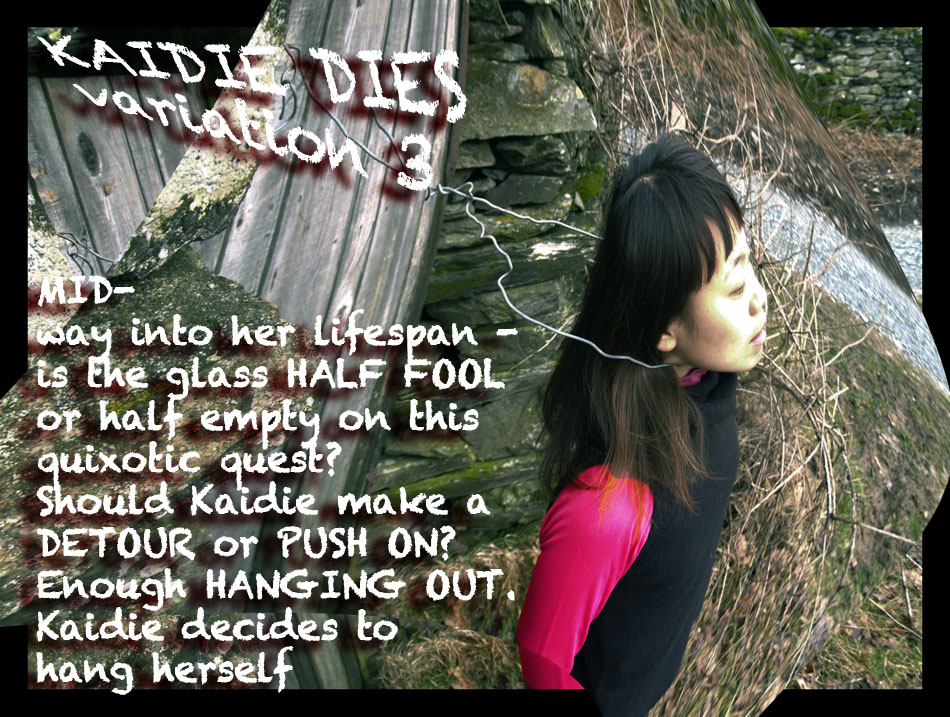
Photograph by Trespasser on his mobile phone as he ran into this death scene while on his morning run this morning. After he twat this picture, it went viral, because of the e-coli pandemic, because of the poisonous mung beans, because of the flimsy wire holding Kaidie's neck, because of suffocation, because of tension, because of coughing, because of hiccuppings and hiccdownings. Trespasser's site has since been closed. Nonetheless, the photograph still survives, stubborn as the bacteria, which thrives in warm feces (cold ones turn white and hard, like corpses, like carcasses, like that of Kaidie's).
CRUSHING DEATHS, CRUSHING LIVES: We seek not immortality (as if one lifetime is not more than enough!!) or happy afterlives (we yield not to bullying and blackmails by institutions); we fear not death, but life itself, and how we are living/running it.
As we run inter-dimensionally across Life 1.0 and Life 2.0, we run in the chaosmos of mortality and immortality. Traversing backwards and forwards between living-subject-to-death and never-dying, the inter-dimensional runner is able to get best of both worlds. In such a setup, life and death become a multidirectional circle. Living or running in such a circle, any existential angst can be extinguished: we live (each) life to the fullest and cease fearing death. Instead of mourning for the dead, we sing, as Zhuang Zi (Chuang-Tzu) did after the death of his wife. ‘If I were to follow after her bawling and sobbing, it would show that I don’t understand anything about fate.’[1] Zhuang Zi looked at his wife’s death as another stage of life, as a continuation from ‘the time before she was born’ (which itself was a stage after ‘the time before she had a body’, which was in turn after ‘the time before she had a spirit’.) For him, ‘just like the progression of the four seasons, spring, summer, fall, winter,’ death is merely ‘another change’. As Sinologist Norman Girardot explains, the initiatory symbolism of returning to the condition of either infancy or death echoes the cosmic return to the chaos condition.[2] In this mixed, third condition, infancy and death are ‘symbolically equivalent’. This is the Dao’s (Tao’s) creatio continua. When a man dies, ‘he goes to his rest, rises again to his zenith’. This ‘return to the beginning’ after our death is ‘the ultimate harmony’, and is the chaosmos of mortality and immortality that the inter-dimensional runner is able to enjoy.
Daoist (Taoist) expert Kristofer Schipper observes that these notions (life and death as circular, and death as transformation and renewal) are clearly embodied in Lao Zi (Lao-Tzu) himself, as well as the mythological circumstances of his birth. Across literature such as the appropriately-named Book of Laozi’s Transformation and Book of Endless Mutations of Laochun (another name for Lao Zi) and so on, the Old Master says: ‘I transform my body, passing through death to live again… I die and am reborn, and each time, I have a [new] body.’[3] True to form, Lao Zi is said to have gone through nine transformations before he was born, and was hence born already an old man. Yet another example of these ‘continuous mutations, this joyful changing according to time’s cycle and the nature of things’, is the story of how the ‘Old Child’ was an orphan free of baggage, knowing ‘neither parents nor children, neither lineage, nor country’, and ‘no tomb nor holy relics’.[4] In yet another version of the story of his birth, the ‘Old Lord’ was said to be ‘his own mother’. The theme of the juxtaposition of life and death is most poetically encapsulated in the version that says that Lao Zi’s mother died ‘[at] the sight of her offspring.’[5] In the ‘brief moment between birth and apotheosis’, it is said that the Mother ‘reveals to her child the secrets of the art of immortality, of that ‘Long Life’ which the Old Child has just experienced in his mother’s womb’. Where there was ‘neither birth nor death’, a complete cycle of the cosmos was accomplished.’ To the Daoist, death and life are but ‘2 phases of a cycle’, with an ‘alternation analogous to that of yin and yang’.[6] All the stories of Lao Zi’s birth point to the same thing: that the ‘organic round of life and death’ is but a ‘rite of passage’ that ‘constantly involves moments of growth and regression, security and danger.’[7]
Yet, even though death is not considered as an ‘ill’ in Daoism, but as ‘only one phase of the total process of human life in time’,[8] prominence is still placed on achieving a good quality of life before death. This is where the notion of yangsheng – the preservation of life and nourishment – returns. In fact, the emphasis is not only on a good journey before life, but a good long distance journey before death, with longevity and, as an extension of that, immortality as the aims of yangsheng. Indeed, Schipper goes so far as to say that it is legitimate to ‘link the classic works (the book of Zhuang Zi and the Dao De Jing [Tao Te Ching]) as do the Daoists themselves, to the search for immortality […].’[9] While there are mystical elements (as we have seen in the case of Lao Zi for instance, who was said to have lived for thousands of years), the Daoist concept of immortality is primarily focused on everyday reality, through real-life practices including medicinal science and physical exercise, as we have already established at the beginning of this Chapter. Hence, when we run inter-dimensionally, in the chaosmos of Lives, not only do we run to-and-fro the circle of life and death, we also ensure that, before dying, we run a good, long distance life.
[1] Zhuang Zi, ‘The Complete Works Of Chuang Tzu’, Terebess Asia Online (TAO), trans. by Burton Watson <http://www.terebess.hu/english/chuangtzu2.html> [accessed 13 January 2011].
[2] Girardot, N. J., Myth and Meaning in Early Daoism: The Theme of Chaos, Three Pines (Three Pines Press, 2009), p. 126.
[3] Schipper, Kristofer, The Taoist Body (University of California Press, 1994), p. 116.
[4] Schipper, p. 166.
[5] Schipper, p. 122.
[6] Schipper, p. 37.
[7] Girardot, p. 5.
[8] British biochemist and Sinologist Joseph Needham 1974, 77?84, quoted in Girardot, p. 5.
[9] Schipper, p. 15.
RUNNING = LIVING = RUNNING. BUT WHEN WE HIT THE WALL MID-JOURNEY, HOW CAN WE FIND THE STAMINA TO COMPLETE IT?
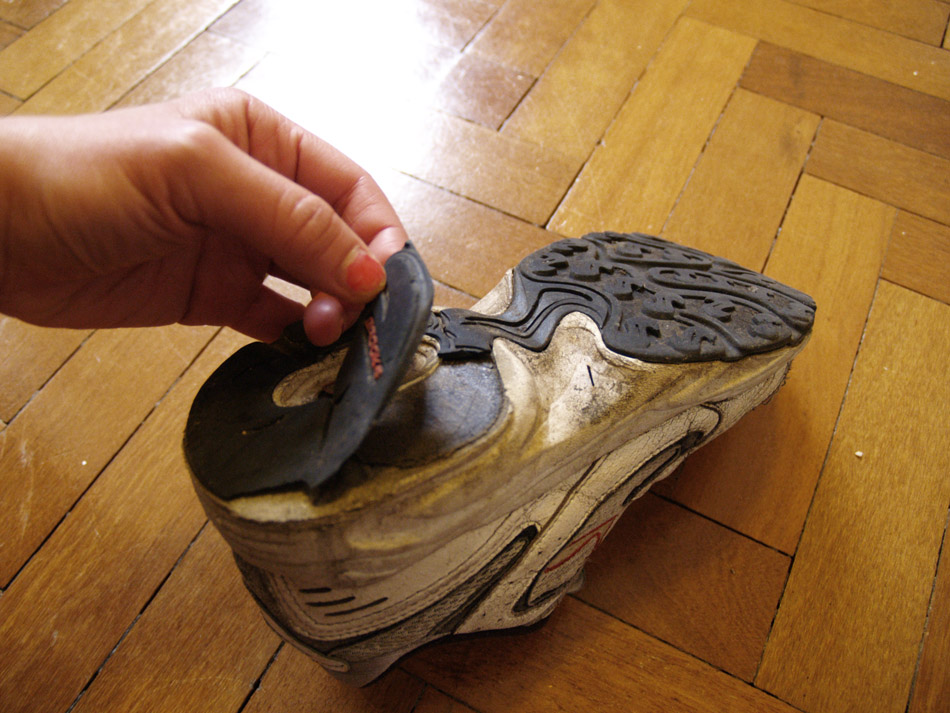
Broken. (Super-)Glued several times, but falling apart (looped, like a broken record, like living, like the cycles of life and death, like dying, like running, like running on quicksand, like running on slowsand, like not running, but running, still).
For me running is both exercise and a metaphor. Running day after day, piling up the races, bit by bit, I raise the bar, and by clearing each level I elevate myself. at least that’s why I put in effort day after day: to raise my own level. […] The point is whether or not I improved over yesterday. In long-distance running the only opponent you have to beat is yourself, the way you used to be.[1]
We journey forwards to the finishing line in a running session (or at the completion of a race, which is the epitome of a running session, with set rules and a clear beginning and closure). In life, we journey towards the finishing line of death. In the process, like writer Haruki Murakami, we desire improvement and progress in any given run, as we do in life itself. Yet, any long-distance runner also understands the dictum that when we run, we are essentially running against ourselves (and not our fellow runners). As Bernd Heinrich states of his record-breaking championship in the 1981 ultra-marathon, he was running it ‘all by myself, against myself’; ‘I’d done the best that I knew how at the time. That’s what mattered to me.’ [2] Contrary to the short distance sprint, the emphasis of the long-distance run is its process. Given the strenuous nature of running, pain and exhaustion are the Achilles heels of any runner, capable of literally and metaphorically bringing us to our knees. Especially in the case of ultra-running (of distances above 42km), it is when our body and mind are pushed so far that we are reminded of our limitation, vulnerability, and indeed, mortality. For Murakami, ‘learning something essential in life requires physical pain’ in most cases.[3] Yet, while ‘the hurt part is an unavoidable reality’, what matters is how we respond to this pain.[4] Thus, ‘[p]ain is inevitable. Suffering is optional’.[5].In bringing us close to death, pain is that which reminds us that we are alive. We run after pain because it reminds us of our mortality. An undertaking such as endurance running fulfils this basic instinct of ours. Like the endurance hunt, the race becomes a metaphor for life and death, except that instead of competing against the nimble antelope, we are fighting against ourselves, outrunning our own limitations. No stranger to pain, Murakami states that it is ‘precisely because of the pain, precisely because we want to overcome that pain, that we can get the feeling, […]of really being alive – or at least a partial sense of it.’[6] Hence, that which is at stake as we journey in the process of a run or life itself is how we respond to the ups and downs that confront us along the way. In another words, how we negotiate, manage and navigate our runs, and, indeed, our lives —which is the question that we are addressing in our thesis of Trans-dimensional Running For Our Lives! A Rough Guide to a Critical Strategy for our Technologically-Layered Multiverse .
In fact, Murakami’s What I Talk About When I Talk About Running can be read as a poetic discourse of the activity of running as a means to negotiate, manage and navigate his life and mortality itself.[7] Over a collection of essays, he discusses his peak as a runner (and writer), and contemplates about his own physical decline as a runner as he grows older.[8] In contrast to the image of a highly-successful novelist and athlete, the essays reveals Murakami as one ridden with anxieties and self-doubt about (his) existence. In tones not dissimilar to Antoine’s epiphanic laments in Jean-Paul Sartre’s existential textbook Nausea, Murakami ponders about whether he has overcome his ‘shortcomings’ as he ages (‘now here I am living in this unimaginable world’;[9] ‘wretched sort of feeling’;[10] ‘struck by how pitiful n pointless this little container called me is, what a lame, shabby being I am’;[11] ‘sad spreadsheet of my life that reveals how much my debts far outweigh my assets’[12]). In a particularly poignant (and humorous) passage, Murakami describes watching ‘young blonde girls’ swinging their ponytails ‘proudly’ as they run, and distils from it the metaphor of how ‘one generation takes over from the next’. He allows them to overtake him, for they have different sense of time, which is ‘the way it should be’.[13] For Murakami, ‘this is how the world is handed over in this world’. He continues to run his own run —and his own life— and comes to terms with (his) mortality:
[…] I doubt I’ll ever be able to run the way I used to. I’m ready to accept that. […] And time does its job much more faithfully, much more accurately, than I ever do. Ever since time began (when was that, I wonder?), it’s been moving ever forward without a moment’s rest. And one of the privileges given to those who’ve avoided dying young is the blessed right to grow old. The honour of physical decline is waiting, and you have to get used to that reality.[14]
[1] Haruki Murakami, What I Talk About When I Talk About Running (Random House Inc., 2009). p. 10.
[2] Bernd Heinrich, Why We Run: A Natural History, Reprint (Harper Perennial, 2002). p. 266.
[3] Murakami, p. 140.
[4] Murakami, p. vii.
[5] Murakami, p. vii.
[6] Murakami, p. 171.
[7] Thirty-three —which he notes was the age that Jesus Christ died and Scott Fitzgerald began to decline— was the age that Murakami picked up running (as well as his ‘belated, but real starting point as a novelist’). Murakami, p. 47.
[8] Murakami, p. 11.
[9] Murakami, p. 18.
[10] Murakami, p. 152.
[11] Murakami, p. 152.
[12] Murakami, p. 152.
[13] Murakami, p. 94.
[14] Murakami, p. 121.
Mathematically-speaking, we SHOULD take 4 hours to run 42.1km. Non-mathematically-speaking, we may take 40 hours.
How long will we take to complete 42.2km at the Nondon Marathon on 17 April 2011? We will finish, by hook or by crook or by crawling. But the million-pound (or £1500) question is, in what time? To be sure, every run is different, and every race – a particular competitive run session with a specific start and finish across a set route; a heightened run session – comes with its own sets of quirks. The variables are infinite (climate, route, scenery, traffic, fellow runners, clothes we wear, if the race is well-sign-posted, audience/spectator-support, number of yummmmmyyyyy jelly-babies [and Snicker bars] we manage to pop into our mouth en route at feeding stations, et al), but we can begin by examining our running and race history: (Go ahead and mock, spit, laugh at us, but you would have realised by now that we are painfully slow coaches, such slow runners we are that we are probably better off walking, but at least we have lasting power for the endurance race of our lifetimes…)
1) 2010 March: 10km race by the Friends of Medicin Sans Frontieres Nondon: This was an easy race of 10km which we completed in 52 minutes, which works out to be a speed of 11.54km per hour (or 7.17 miles per hour), or a pace of 5 minutes 12seconds for every 1km (0.822 minutes per mile) It began as a crisp early Spring morning but turned 8 degree celsius, so we were dressed in short-sleeved and long tights, although we were carrying the burden of stomach cramps (!!! TMI !!!). In this race, we raised money for the Medecins Sans Frontieres. We had been kidnapped before the run, was released on time by The Good Pirate.
2) 2010 September: 42.2km: Farnham Pilgrims’ Marathon, Surrey. This was our first ever full marathon, which we ‘accomplished’ (sic) in a disgraceful 5 hours 29 minutes! We have plenty of excuses, however: 1) it was off-road in a hilly terrain – we stopped to WALK at a steep hill climb at a point (it was said that most runners had to add 30 minutes to any of their times for this race) 2) We had spent the entire summer running all over Nondon, in a bid to train for our first ever marathon. However, in the final 2 months, we were brought down by injury (tendonitis and shin splint), which came with us to Farnham. Yet we do not fret, and were delighted to have completed the race. All in all, it was a most wonderful experience, against the gorgeous and meaningful mise-en-scene that the pilgrims had once walked, the fellow runners a tremendous joy to be with, and beautifully organised. We also raised a weeeee bit of money for the Farnham hospices.
3) In a previous life: 2009 August, Singapore, 21km (13.1 miles) SAFRA Bay Run Half-Marathon: This was our first ever race since casually picking up running in January 2009 in a previous life, at the same time of still being chlorine addicts. We took 2 hours 21 minutes – which is the amount of time taken by the world’s elite runners to complete FULL marathons!! However, we were not displeased, with the high humidity, and at 30 degree-celsius of the (paradisal) tropics. We are proud however of the fact that in our final 4km sprint, we managed to bypass 655 men and women (and yes, allowed 20 to bypass us). Running alongside more than 20,000 people of all size, shape, age and colour was also tremendously enjoyable. By default, happiness and pleasure are inevitably short-lived- but our entire 2 hours 21 minutes was a skyrocketing morphine-high. It was an extraordinary trip.
So. How on (google)earth would we fare on 17 April 2011?
1) For the first / last 450 days of our lives, we have been working hard at our running. Outside of a race, our comfortable pace is approximately 10kmh – 10.5kmh. At this pace, there is neither exertion nor discomfort. (Under artificial conditions, inside the gym, our average is around 10.5kmh – 12kmh, though this figure we should ignore, since it is climate-controlled, and we are running on machines that move nowhere, hence using different muscles of our body. The psychology of such locomotion differs from that outdoors as well)
2) Since February, we have been training longer distances (20km and above), but our fourth toe on our right feet has been harvesting a blister (!!! TMI !!!) This has never happened previously so we are slightly worried, wondering if we should go ahead and buy a new pair of shoes of a slightly larger size. Yet, already armed with three pairs of trainers, we do not want to buy another pair right now. Then there is also a new bone-like thing sticking out of our left feet recently, that prevents us from wearing any shoe without feeling pain. (!!! TMI !!!) Again this is new, and did not happen in our Summer training.
3) The past year of running means that our technique would have improved, but at the same time, we are aging as we speak. We are juvenile at 430-days-old, but because we have only 1000 days in our lifespan, we are nearly middle-aged. While we come with the charms and beauties of a mature wine and even more mature blue cheese (as well as iron-will power, truckloads of stubbornness, and plenty of drive), we might not win a spring chicken in a photo-finish. We will come back to this issue of running and mortality in a separate post.
4) As anybody knows, there’s such a silly law called the law of diminishing returns. Whichever sillier eejit came up with it, we have no idea, but when it comes to a slowburning, longhaul endeavour as a long-distance run, no one is sparred from this law. We can get increasingly worn out and deriving less and less satisfaction from the run over hours and distances. And from experience, we know that we are excellent practitioners of the law. This can translate what should take 4 hours into to a pathetic epic 5 hours (first 10km takes 1 hour, because we are warming up and do not want to over-exert; for the next 10 km we dip a little, as we are still conserving our energy at 1 hour 10 minutes; then the 30th km takes 1 hour 20 minutes, and for the final 12km, we have the sudden epiphany that we have to get our arses moving, and hasten a little but alas it is too late as our glycogen-levels would have deteriorated so we complete it in 1 hour 30 minutes).
So there we have it. On 17 February Sunday, we may take anything from 4 hours, or, 40 hours.
But let us think of positive thoughts. Next year, in our final year of existence, we would like to sign up for the midnight sun run in Norway. How beautiful and hyperreal an experience it would be. And, with all that sunlight one cannot possibly sleep anyways, so why not go for a run. For a few hours, the duration of a sleep. We currently devote about 8 hours of exercise each week (at least an hour a day); training for a marathon means a minimum of 10 hours or exercise each week. We must not neglect our run in other dimensions, so this running about in Life 1.0 may be taking up just too much time. We decide that the half is the best distance for us, also since we can sustain happiness for a maximum of 2 hours at any one go. Anything beyond that, at 4-5 hours for instance, the law of diminishing return sets in and the dreaded dip, the hitting-of-wall happens. 10km races are too fast/short. Hence, we intend to take part in the 2012 Bath Half Marathon. With a companion.
MONSTER (a poem of love and its opposites). HAPPY VALENTINES DAY.
Premiered at Oxford University UK, at the ‘Human- Machines, Mechanized Modernity, and Mass Subjectivity between Asia, the Soviet Union, and North America in the Twentieth Century’ conference, June 18-20, 2009. Music by Philip Tan. Special thanks to Aaron Moore, Tina Chen, Sarah Teasley. Created by a predecessor of Kaidie’s in a previous life, Kai Syng Tan, May 2009 Singapore. The opening lines in the 2nd act of the film are taken from Cascando by our most beloved Samuel Beckket.
Monster is a video poem seen from the point of view of an elderly woman, who really is an imagination by the artist of herself in the near future. Monster addresses man’s eternal obsession in modifying his body and nature in a compulsive bid to ‘improve’ himself. Such notions as the frailty of the body & flesh, and how our body-machines decay and imaginations of means through which we sustain/prolong/improve on them, are teased out. With the classic allegory of Frankenstein as a point of departure, the work posits the Man vs. Machine/Monster argument as a complex and layered relationship that is at once dependent, violent, obsessive, loving and destructive. While ‘I’ (Man) have created ‘you’ (Machine) out of a need for survival, ‘you’ have fought with me against (my) nature, but entrapped me nonetheless; my selfishness, greed, ambition and insatiability has led me to create an indomitable Monster/Mutant that is increasingly out of control – yet I remain faithful, and continue to love, nurture, and protect you. And I get hungrier still. This man/machine dance/wrestle is a powerplay that is paradoxical, grotesque and tender at the same time. Incorporating text, performance and animation, Monster is accompanied by a haunting soundscape made up of sounds from construction sites – an all-too familiar sound that fills the artist’s ears in the high-tech Asian miracle city that she hails from. The shiny images of the city-state in a relentless process of construction and rebuilding are juxtaposed with personal, intimate images of everyday objects photographed in the artist’s home – used, forgotten, dusty as they are. We go up close to the skin of an elderly lady, whose life overlaps that of her daughter’s. Happy Valentine’s.
In the chaosmos of RUNNING AGAINST and RUNNING AWAY: Our deliriouslydelicious 6am loops in myopicdarkness at Regents Fark. Alternatively, hitting the hamster wheel.
In the face of a snag, what can we do?
1) Our natural (insofar as there is such a thing as nature?) instinct is to fight it. Resist it. Put up a bloody good brawl and, if in the end we are nearly dead from the bloodiness, at least we have put up a good fight.
2) Yet, if fighting seems futile, and if it is wiser to not fight but fight by opting out, so be it. Rather than a sign of weakness, running away is a tactic of survival and can be a wise sign of strength, too. The Tarahumara Indians of North Mexico – superathletes capable of running ultradistances for days on nothing more than skimpy rubber sandals – first resisted the colonisers by running. The more danger encroached, the further and deeper they ran. As Bernd Heinrich observes (and reports of himself), (we) runners are guided by dreams and madness as much as we are by logic; stubbornness (the sisu that we see in the amazing flying Finns) and resilience as much as pragmatism.
In December, as Nondon experienced what has been repeatedly described as ‘unprecedented’ ‘arctic’ weather conditions, we ran into the conundrum of ‘running away from’ versus ‘running against’. We were undecided if which was better (or the lesser evil), to fall in icy conditions outdoors (as we did in January 2011 in the Swiss alps while visiting Heidi, and on 17 December on our way to the opening of our exhibition), or to admit defeat and run indoors instead and risk falling off the treadmill (December 2009)? Which is a better fall? Which lousy choice is less lousy?
As 1.57m (Yes, when fully erect. Yes, back fully straightened. Yes, neck standing upright.) ex-tropical beings in a most recent life, our war with the Nondon weather looked like a farcical David-versus-Goliath mud-wrestling (or snow-sloshing) match. Yet, in our determination to raise two or ten fingers or twenty fingers and (callused) toes at the weather, we have been undertaking 10km dashes at Regents Fark at 6am, whenever the weather was clear. Being myopic, the darkness protects us from being fully awake and alert, but also grants us an other lens of lucidity, enabling us several orgasmically endorphin-filled sessions. Then, the first heavy snow fell in Nondon in late November, we were initially in denial, and continued to run outdoors. Wrapped up as Michelin Man, we treaded carefully and slowly. Did it feel good? NO, of course not. Running in layers and layers of heavy clothing will never be a comfortable option; neither is having to run watching every single step. In some senses, we could read that this sort of running as so compromised as to not do justice to the notion/spirit of running (do we hear shades of the pro-life versus pro-euthanasia debates here: better a bad quality but prolonged life, or one shortened – perhaps while one is on top of one’s game – but lived to the full?).
Hence we decided that it was perhaps wiser that we stopped being obstinate in trying to outrun nature, but to let her do her job, or whatever it is that she desires or needs to do, and that we went for an alternative option. So, it has been the claustrophobic and soggilyventilated hamsterwheel in a gym for the wussy hamster. Outdoors, we have no problems whatsoever running 10-20km at a pop. On the treadmill, however, we sometimes struggle even with ONE kilometre. Yes. We are shocked too, and could not decide if we should laugh or cry (and use the tears to lubricate our psychological resistance to the machines)? Where has that inertia/animosity/fear come from?
Fortunately, that was then. The arctic conditions seem to have left Nondon, and we are back to our 6am (and lately, 5:30am, for our day does not feel begun unless/until we move our body) runs at our beloved Regents Fark. At the expense of paid gym membership, but feck it. Give us the great outdoors, anytime. (and save us from the disturbing phenomena of swinging ponytails in OFFENSIVELY LOUD west coast accents, trashy TV programmes, short men pumping iron, mouldy floors of showers). We take comfort in the darkness, as if the darkness protects us. On average, we meet (or rather, sense, or run into, and sometime bump into, given that we can’t really see them) about 15 runners (and about 8-15 cyclists, who go about in groups/herds, unlike us runners who go about [in life too?] necessarily [?] in solitude). We say neither ‘hello’ nor ‘good morning’; instead we are quietly work on, as if there is a tacit understanding that we are doing what we have to do. Of particular significance is an elderly (or simply beard-y? For, once again, being myopic, and especially so in the dark, we have no idea) man whose waist is tied to his labrador (or what looks likes of such a dog, for we are not able to differentiate dog-types, though we are certain that the most loathed of the canine family would be the chi*&%hua, which looks more like [somebody’s idea of] a joke. Except that it is unfunny). (We think/ assume it is a dog (?), although once again we have no way to confirm, unless we put on our glasses, but any extra thing we attach to ourselves is but a burden, and surely we do not need any burden, so we will have to take it that it is [or was] a dog.). A strong dog (and master) this labrador, or labrador-ish dog is, for it runs at a very strong and confident pace, every morning, leading his master forward. If we had a cat (THE BREATHTAKINGLY BEAUTIFUL BRITISH BLUE, FOR INSTANCE!!) we would train her to do the same for us. The weather has turned muggy, so much so that we have been sweating unseasonably more than usual, and the dry-wick shirts do not help.
Could we possibly use our excess(ive) sweat production to lubricate the hardship and human and inhumane suffering that is to come in the remaining 593 (!!!!!!!!!!!!!!!!!!!!!! ONLY!!!!!!!!!!!!!!!!! ALREADY!!!!!!!!!!!!!!) days of our life?
THANKS to EMMANUEL, SHEA, ANONYMOUS and ERIC, SPRING HAS COME EARLY TO NONDON. GBP £600 raised for our marathon – another £1000 to go.
When Spring arrives, cherry blossoms bloom. The time when cherry blossoms bloom indicates the beginning of the new year, a start of something new. A start of something new also means the end, or death, of something not new. It is only the middle of January, but Nondon has been seeing double-digit temperatures (Celsius, not Fahrenheit, darling. While we are at it, not the imperial system, not inches and feet. Nor stones, nor yards, nor miles, darling). It has been so warm that we have been running in sleeveless tops (Nike Dri-fit) and shorts (Nike-somthing-or-other)- still we sweat, as slimy roast pork does, as if it is Spring, even as if Summer. We run best when we run/feel/are light; last Thursday, at a muggy 13 degrees celsius, we ran a strong 17km exploding with endorphins along the canal, to Victoria Fark and back again. It was one of our happiest runs of late.
Last Saturday, we passed the GBP£600 mark in our donation drive for our run for Shelter at the 2011 Nondon Marathon, ALL THANKS TO OUR FRIENDS EMMANUEL, SHEA, ANONYMOUS and ERIC AULD. THANK YOU VERY MUCH – your very generous support has given us a lovely push in the midst of a still dire economic crisis. We have 2 months left. Just another £1000 to go. Go we will!
Let us end this little post with a little quote from writer-runner Haruki Murakami. We are not usually fans of his work as we find that they can be a little too cute, but we slurped up What We Talk About When We Talk About Running in a matter of hours (in the midst of writing/repairing 15,000 of our own words). That which we find meaningful, we will have to devote another fresh post to, but at this point, with the photograph of the unseasonable cherry blossoms in the middle of Winter in Nondon, we want to juxtapose the very final paragraph of the book on page 197 here:
Some day, if I have a gravestone and I’m able to pick out whats carved on it, I’d like to say this: ‘Haruki Murakami 1949 – 20** Writer (and Runner) At Least He Never Walked.’ At this point, that’s what I’d like to say.
As we fly 18,948km Nondon-Sao Paulo (return), WE WILL RUN 189.48km IN LIFE 1.0 BY 7 NOVEMBER TO MAKE UP FOR OUR CARBON FOOTPRINTS (yes we are wussy by moving a couple of decimal points, but better a pathetic gesture than none??)
As you know (do you? did you?), we are flying to Sao Paulo this weekend to participate in Soft Borders: 4th Upgrade! International Conference. In this gathering of artists, curators and academics from 30 countries, we will be making a 20-minute presentation of our fabulouslyfeetstompinglyheartstoppingmindblowing theory, Trans-Dimensional Running For Our Lives! A Rough Guide To A Critical Strategy For Our Technologically-Layered Multiverse Today. Seasoned (ahem) and weather-beaten (ahem) world- and out-of-the-world- travellers that we are, this will be the very first time that we visit ‘that part of the world’. So, our Dear Conspirators of Pleasure, should you have any tips (Where would be interesting places to run? What to eat? What to drink? Whom to meet? What to do? What to say? How to say? etc. But unfortunately, no, we are not able to drop by at Rio for the famous beaches and silicone…) about the trip, do let us know! And, as usual, if indeed your advice is so amazing as to afford us an amazing experience or two, we will create and publish a post here to share with everyone!
As trans-dimensional runners, we would have liked to fully practice and live what we preach, of course. Nonetheless, for us to run all the way from our favourite city on earth and beyond (thus far), Nondon, to Brazil, would take a while. At 9474km one way and a grand frolicking 18,948km return (!!!), it would take – to put it mildly- ages. Recall now that we live only for 1000 days, and we have only 695 (!!!!!!!!!!!ALREADY!!!!!!! Time flies whether or not we are having fun, however we define ‘fun’, or not) days left. so for us to run to Brazil and back, we would bust our given duration many times over, and be fropped left right centre.*
*It would be appropriate at this point in time for us to have a reality check and undertake some scientific calculations: Someone at our recent ARTSingapore gig asked us how much we have run in the past 305 days of our existence. Good question, we thought. We know that we run an average of approximately 60km a week – sometimes more, sometimes less. On some days, we have 5km quickies, of speed training (we say ‘speed’, but we are pulling [y]our leg[s], as we all know by now that when it comes to running we don’t/can’t do hit-and-run quickies, unless you release an repugnantlyyelpingly ridiculousness of a ‘dog’ of a chihuahua behind us, or, ahead of us, a glass of crisp bubbly, but otherwise, we will not/can not sprint, and our running is no where near the word ‘speed’ and its variations – we do endurance and go the whole length for hours and kilometres [for instance, 1 kilometre per hour], but we simply just don’t Bolt, sorry) on the treadmill or elsewhere, and on others, we run outdoors for approximately 10-20 km. To deduce that we have run approximately a total of 2500km in the past 300 days should not be all that far from the truth, which works out to be an average of 8.3333km per day). All that said, we must confess that some days we do not run, but run off instead to conduct our illicit and addictive affair with an old and very brilliant flame, chlorine. (By definition, any affair would taste sweet because they are affairs [whether or not the affairs themselves are of any good]; illicit affairs are even sweeter, and intrinsically and necessarily so, simply because of their illicitness… Hence, in spite of our vocation/mission of trans-dimensional running in this life, our ongoing stubborn dalliance with swimming in madmade pools…)
Several of your would recall a previous trip that we undertook, to visit our Facebook Friend, the legendary Heidi, in Heidiland (YES HEIDILAND EXISTS), Switzerland, during our 3rd-lifer-In-Residency in Winterthur. The return journey between Nondon-Zurich was 1550km, and after several days of wrecking our brains, we worked out a sophisticated and sustainable system of a means to compensate for our dirty carbon footprints. We understand that not all of you are as mathematically able as we are, so, to explain it in very simple means for you, it suffices to say that our system involves the movement of the decimal point to a position that would render the distance run-able for us, within a decent period of time.
Now, our Dear Fellow Runners, do understand that decency is the governing concept here- for our ‘system’ of repayment of our carbon footprints has to be sustainable and do-able. Running 18,948km would have taken us AT LEAST 1894 days if we run an average of 10km a day, which is 894 days over and above our lifespan (and we have already spent 305 days). Running 1894.8km would still take us about 189 days or 6 months. Also, we are currently in discussion with Japanese art workers about a trip in December/January/February to Asia as part of a project, which would cost at least 10,000 km – ONE WAY. As already argued in January when we undertook our trip to Switzerland, we had already acknowledged that this is but a gesture, and there is no thing big enough we can ever, ever do to compensate for our continual slow smothering of the earth. Apart from having vowed from day one (actually day zero, many life cycles ago) not to create mini-mes to add even more wrongs to all the wrongs that are already happening and all the wrongs that we are already committing, we are also cutting short our lives, and making us put in physical effort every time fly. We have heard of some other gestures such as making donations to have trees planted whenever one flies, but we are uncertain of the impact of such a deed – it does not hurt those with deep pockets and merely buys them out of their guilt (as Zizek has eloquently and sweatily articulated elsewhere). Insofar as all gestures are vain, our tactic of running to repay for our carbon footprints amounts to not much (if anything) either, but as it requires one to put in slightly more physical effort (other than the physical effort of clicking a button to agree to donate money to plant a virtual tree and alleviate one’s guilty conscience), it certainly makes one (us for instance) think twice about flying. And we speak as guiltyfrockers who absolutely adore being in mid-air in large machines, suspended in time, space, cultures, nations.
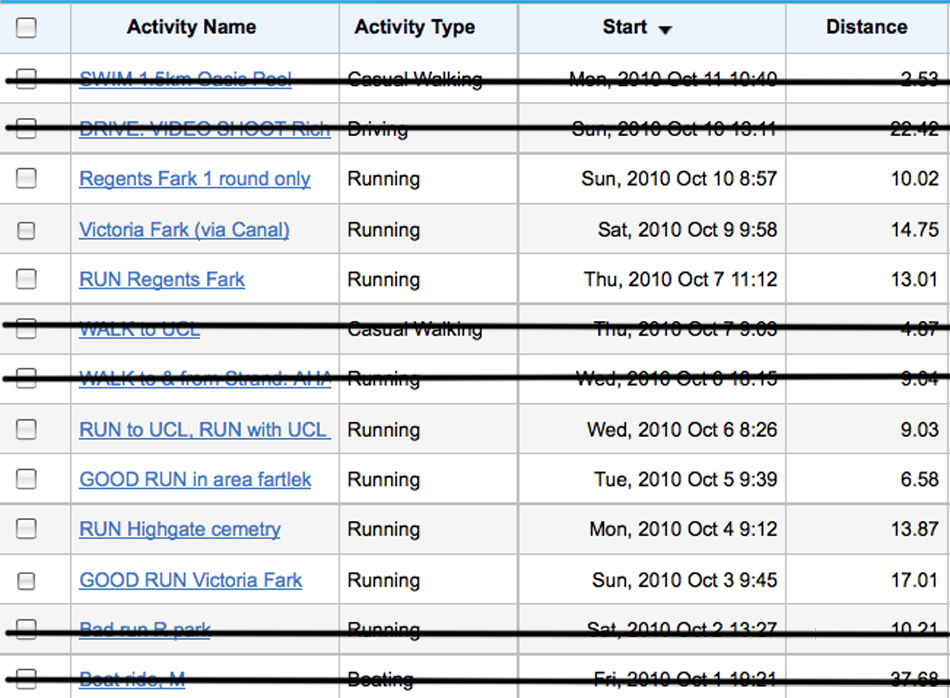 As we can’t spend the rest of our lives to pay for our Nondon-Brazil return journey, we will move not one but TWO decimal points, to run a total of 189.48km by the end of this month. We begin this repayment from 3 October, when we properly resumed our running (after resting for 2 weeks on our laurels and gloating in the glory of our completion of our first Life 1.0 marathon). So far, over the first 7 days, we had covered 84.27km. Note that although we had had some lovely walks (and a funny dip in Thames!) with some of you during this time, they are not counted, as we will only consider running, and of distances above 5km at any one time. We have 15 days left to run the remaining 100km or so, so we’d better get our magnificent inertia and monumental butts moving.
As we can’t spend the rest of our lives to pay for our Nondon-Brazil return journey, we will move not one but TWO decimal points, to run a total of 189.48km by the end of this month. We begin this repayment from 3 October, when we properly resumed our running (after resting for 2 weeks on our laurels and gloating in the glory of our completion of our first Life 1.0 marathon). So far, over the first 7 days, we had covered 84.27km. Note that although we had had some lovely walks (and a funny dip in Thames!) with some of you during this time, they are not counted, as we will only consider running, and of distances above 5km at any one time. We have 15 days left to run the remaining 100km or so, so we’d better get our magnificent inertia and monumental butts moving.
Watch this space for our updates, and cheer us on. Or, go right ahead to mock and boo us for being such a wuss, but we are trying, alright?
Our Bras Basah Station permanent public art work post #4: 2 RE-PRESENTATIONS
Above: A trailer of the 29-minute video cycle; below: a re-presentation of Desyphus in-action on the site in Singapore, by wacky Singapore filmmaker Chew Tze Chuan. As we have not seen the work ourselves, do upload it if you run into it, and tag it ‘bbs’!
IN ONE OF HER PREVIOUS LIVES, KAIDIE WAS DESYPHUS, SWIMMING ROUND AND ROUND THE CIRCLE LINE IN SINGAPORE. The Bras Basah Station permanent public art work post #1.
* Read about Bras Basah Station on Wikipedia.
* Read about the Circle Line on the Land Transport Authority site.
* Read about the Circle Line on Wikipedia.
* More information and images of the Circle Line here and there.
* Read about award-winning station designed by critically-acclaimed WOHA.
* Look up images of Bras Basah Station on Flickr.
** LAST 2 DAYS OF THIS MONTH TO VOTE! Currently a top film in the War of Films contest: CLAUDIA TOMAZ’S film about KAIDIE AND HER MEANING OF LIFE 3.0. VOTE NOW!** Vote by clicking on + sign at the top of video player. ** Don’t forget to vote for Episode 2, Run Kaidie Run, too!**
HITS & MISSES, FITS & KISSES: Let’s agree not to run into each other, but won’t you let us take us for a ride? GAME FOR A COLLABORATION WITH US ON OUR EPIC QUIXOTIC QUEST?
The trans-dimensional runner of this quixotic life has at any one time one foot on the ground, pragmatic/rational/grounded in sturdily hardcore realism, and the other airborne, in cuckoo land and blue skies, with extra-terrestrial visionary eyes on each (swollen) toe, taken with skyscraper-tall mountains of heartattacky salt.
In this Web 2.0 Do-It-With-Others storytelling exercise, we have been privileged to have undertaken several collaborations with you, in our quest for the Meaning of Life 3.0. Here is an other idea for a collaboration (first conceived in early 2010):
As it is, we have not met 99.782 per cent of you, given that our interaction has been only in Life 2.0, ie, via the channels of this running blog, Facebook, Youtube, GPSies, Twitter and so on – and our imagination, of course. Also, given that we are partly an imaginary creation, meeting in real life is possibly an unimaginable task. (That said, we do not think that encounter in one dimension is of lesser or more significance than an other) In this idea of a project, to make the point that we want to maintain or create a critical distance between us, let us go out of our way to deliberately not meet in Life 1.0. The way to go about doing this is that one person shares her routine over a prescribed period of time. The other person – let us call them the/an ‘anti-stalker’ – will journey on the same route, but intentionally missing the previous person, by a few minutes/moments/metres/centimetres.
The thrill/beauty/cruelty/point of the game is to come so very close to have nearly met – but to just stop short of actually encountering the other. Afterwards, the pair could compare their GPS tracks and find out and plot, point by point, by exactly how much they have missed each other. (And of course, this sharing can be done remotely). As a consequence, one or both parties can derive (perverse / poetic) pleasure from the fact that they could theoretically have been in the same time and space, and could have had an encounter, but willfully and precisely do not. The deliberate orchestration of a denial of a run-in is the point of this project. Hence, we will never come face to face and whisper ‘Hi!’, ‘Nice to meet you!’, ‘Nice to meet you again!’, ‘And who are you?’; one may come close enough to catch a whiff of the other, or sneak a peek of the other’s shadow, or catch a dying footprint, but / and that is about it.
The game can be more fun if more participate. An orgy, not of presence, but absence, with participants who are missing – although we will hardly miss one another.
The great thing about this project is that it is of course hardly original, as many of us are already accomplished practitioners in some degree or an other, but, my Dear Conspirators of Pleasure, do you not think that it will be infinitely (more) enjoyable should we make this a studied and planned collaboration/game, with set parameters to play?
So, are you game? (Ah, the wonders of technology, to allow us to indulge, stretch and realise such fantasies…)
** Currently #5 in the War of Films contest: CLAUDIA TOMAZ’S film about KAIDIE AND HER MEANING OF LIFE 3.0. VOTE NOW!** Vote by clicking on + sign at the top of video player. ** Don’t forget to vote for Episode 2, Run Kaidie Run, too!**
WITH 755 DAYS LEFT ON OUR LIFE (or DEATH) SENTENCE (until the last day of the Nondon Olympics on 09.09.2012), HERE IS AN OTHER MINDMAP OF/FROM KAIDIE’S SEMBLANCE OF LIFE (3.0).
I trust not premonitions and I fear not omens. I flee / not from slander nor poison. / There is no death. / We are all immortal. All is immortal. Fear not / death at seventeen nor at seventy. / There is only reality and light. / There is neither dark nor death / in this, our world. / We have reached the beach and I / am one of those who pull the nets in when / immortality arrives in batches. Live / in a house and it will not crumble. I will summon / a century at will, enter / and build my house in it. That is why / your children and your wives all share my board, the table / serving forefather and grandson: the future is decided now.
As read by Arseni Tarkovsky in Andrei Tarkovsky’s Mirror, 1975
** Currently #5 in the War of Films contest: CLAUDIA TOMAZ’S film about KAIDIE AND HER MEANING OF LIFE 3.0. VOTE NOW!** Vote by clicking on + sign at the top of video player. ** Don’t forget to vote for Episode 2, Run Kaidie Run, too!**

